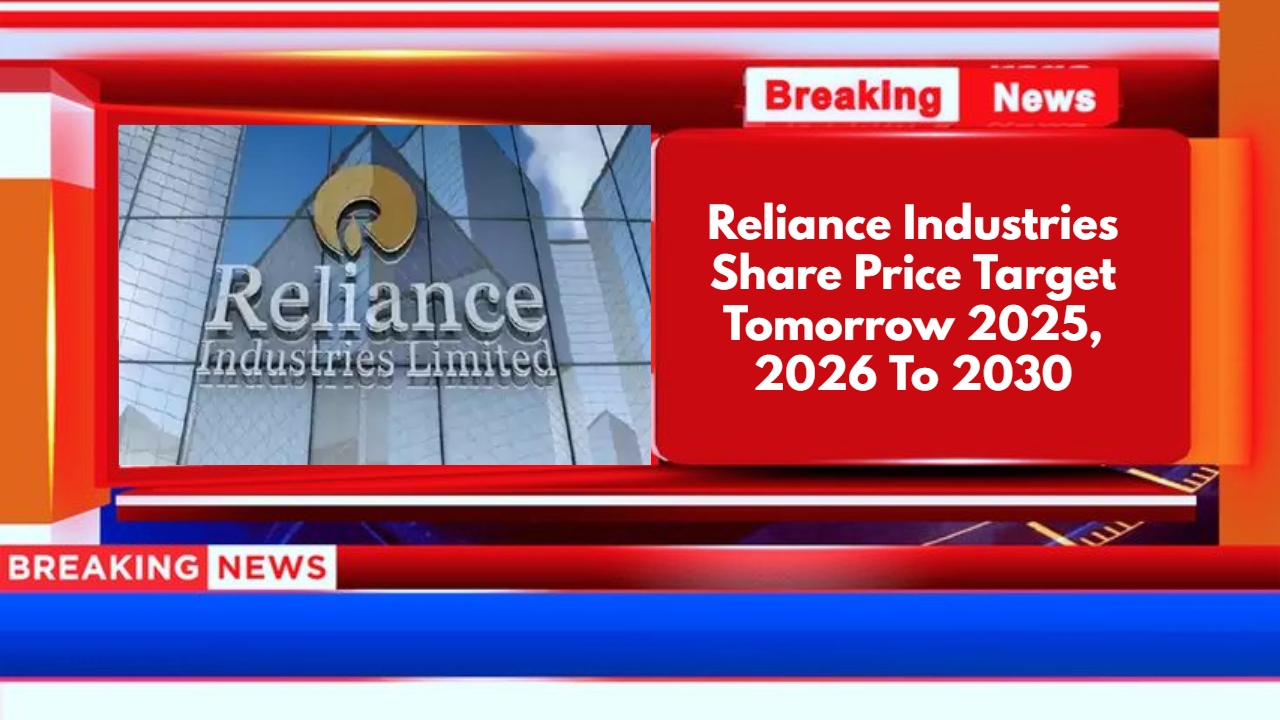Reliance Industries Limited (RIL) is one of India’s most valuable companies, with a strong presence in telecom, retail, energy, and digital services. Investors closely track its share price target as the company continues to expand into new sectors like renewable energy and 5G technology. Reliance Industries Share Price on 2 March 2025 is 1,198.00 INR. This article will provide more details on Reliance Industries Share Price Target 2025, 2026 to 2030.
Reliance Industries Company Info
- Founded: 1957, Maharashtra
- Founder: Dhirubhai Ambani
- Headquarters: Mumbai
- Number of employees: 3,47,362 (2024)
- Revenue: 10 lakh crores INR (2024)
- Subsidiaries: Reliance Retail, Network18, Jio-bp, Jio Platforms
Reliance Industries Share Price Chart
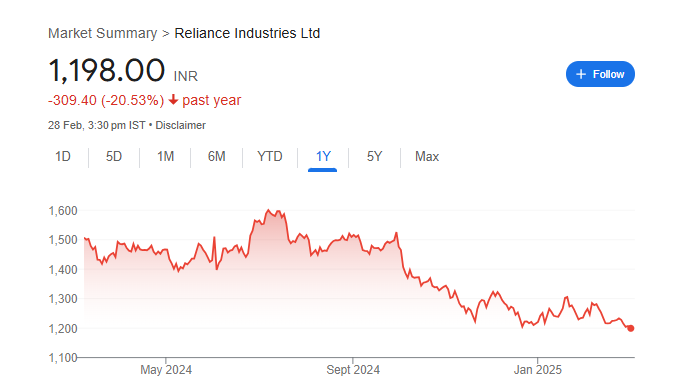
Reliance Industries Share Price Details
- Today Open: 1,202.00
- Today High: 1,217.35
- Today Low: 1,193.30
- Mkt cap: 16.23LCr
- P/E ratio: 23.43
- Div yield: 0.42%
- 52-wk high: 1,608.80
- 52-wk low: 1,193.30
Reliance Industries Shareholding Pattern
- Promoters: 50.13%
- Foreign Institutions: 19.15%
- Mutual Funds: 9.14%
- Retails and others: 11.61%
- Domestic Institutions: 9.95%
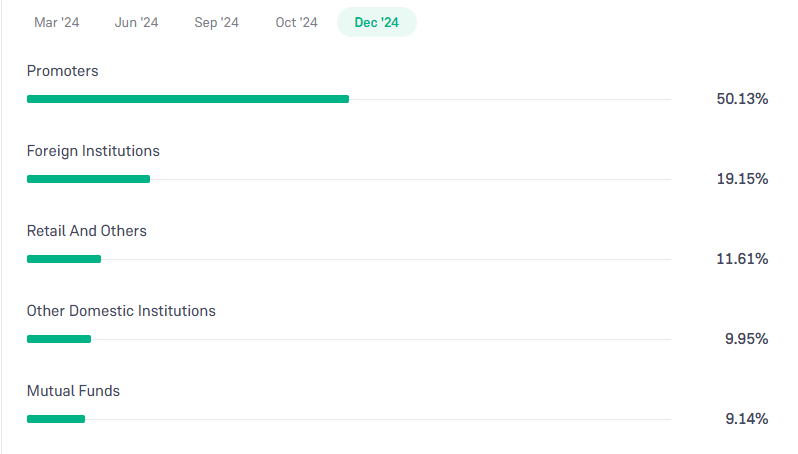
Reliance Industries Share Price Target Tomorrow 2025, 2026 To 2030
- 2025 – ₹1610
- 2026 – ₹1835
- 2027 – ₹2050
- 2028 – ₹2220
- 2029 – ₹2445
- 2030 – ₹2757
Reliance Industries Share Price Target 2025
Reliance Industries share price target 2025 Expected target could be ₹1610. Reliance Industries Limited (RIL) is one of India’s largest conglomerates, with strong business interests in oil & gas, telecom, retail, and renewable energy. Here are six key factors that could influence its share price target in 2025:
1. Growth in Jio and Digital Services
Reliance Jio continues to expand its user base and introduce new digital services. Growth in 5G adoption, cloud computing, and fintech services can significantly boost revenue and drive share price growth.
2. Expansion in Retail Business
Reliance Retail is rapidly expanding across India with new stores, online platforms, and partnerships. Increased consumer spending and e-commerce growth can positively impact RIL’s financial performance.
3. Renewable Energy and Green Initiatives
Reliance has ambitious plans in solar energy, green hydrogen, and battery storage. Investments in clean energy can open new revenue streams and improve investor confidence, driving long-term growth.
4. Global Oil and Gas Prices
RIL’s traditional oil refining and petrochemicals business remains a key revenue driver. Rising crude oil and natural gas prices can strengthen profits, while a decline may impact earnings.
5. Government Policies and Regulations
Changes in telecom, retail, and energy sector regulations can influence RIL’s operations. Favorable government policies in digital infrastructure and renewable energy can support future growth.
6. Financial Performance and Debt Management
Reliance’s strong balance sheet and strategic debt reduction efforts play a crucial role in investor sentiment. Continued profitability and lower debt levels can positively affect the company’s share price.
Reliance Industries Share Price Target 2030
Reliance Industries share price target 2030 Expected target could be ₹2757. While Reliance Industries Limited (RIL) is a market leader with strong growth potential, several risks and challenges could impact its share price by 2030. Here are six key factors to consider:
1. Volatility in Crude Oil and Gas Prices
RIL’s refining and petrochemical business is heavily dependent on global crude oil prices. Any sharp decline in oil prices can impact revenue and profitability, affecting its share price.
2. Competition in Telecom and Retail Sectors
Reliance Jio and Reliance Retail face intense competition from other telecom operators and e-commerce giants. Price wars, changing consumer preferences, and new market entrants could put pressure on profit margins.
3. Regulatory and Policy Changes
Government policies related to telecom, retail, and energy sectors can impact RIL’s operations. Stricter regulations, new taxes, or restrictions in foreign investments could create challenges for the company’s growth.
4. High Capital Expenditure and Debt Burden
Reliance is investing heavily in 5G expansion, retail expansion, and renewable energy projects. While these investments are important for future growth, high capital expenditure and rising debt levels could impact financial stability.
5. Technological Disruptions and Market Shifts
The business landscape is changing rapidly with advancements in AI, automation, and alternative energy solutions. If RIL does not adapt quickly to emerging technologies, it may lose its competitive edge.
6. Global Economic and Geopolitical Uncertainties
Factors like inflation, recession risks, trade wars, and geopolitical tensions can impact investor sentiment and global demand, indirectly affecting RIL’s business and share price performance.
Financials Statement Of Reliance Industries
| (INR) | 2024 | Y/Y change |
| Revenue | 9.01T | 2.65% |
| Operating expense | 2.04T | 9.14% |
| Net income | 696.21B | 4.38% |
| Net profit margin | 7.73 | 1.71% |
| Earnings per share | 51.45 | 4.37% |
| EBITDA | 1.57T | 10.30% |
| Effective tax rate | 24.55% | — |
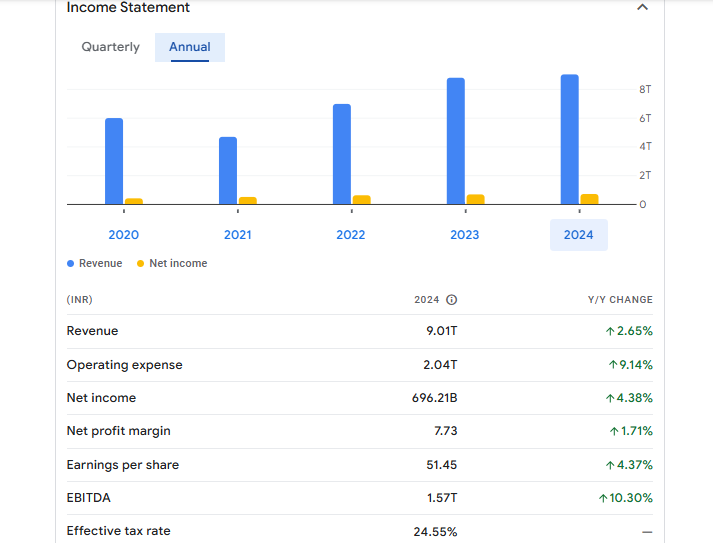
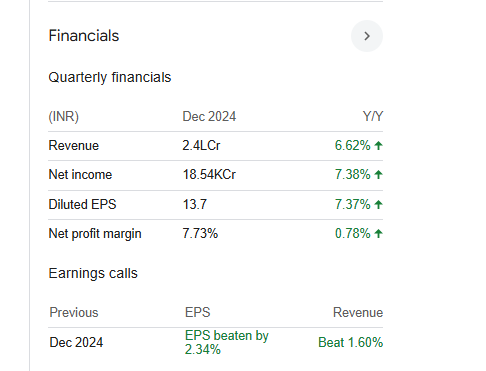
Read Also:- Adani Power Share Price Target Tomorrow 2025, 2026 To 2030

